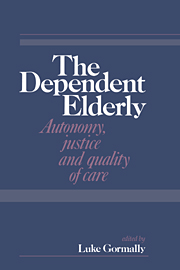Book contents
- Frontmatter
- Contents
- List of contributors
- 1 Introduction
- 2 Difficult choices in treating and feeding the debilitated elderly
- 3 The American debate about artificial nutrition and hydration
- 4 Reflections on Horan and Boyle
- 5 The Living Will: the ethical framework of a recent Report
- 6 Some reflections on euthanasia in The Netherlands
- 7 Is there a policy for the elderly needing long-term care?
- 8 Is it possible to provide good quality long-term care without unfair discrimination?
- 9 The prospects for long-term care: current policy and realistic alternatives
- 10 What is required for good quality in long-term care of the elderly?
- 11 Should age make a difference in health care entitlement?
- 12 Economic devices and ethical pitfalls: quality of life, the distribution of resources and the needs of the elderly
- 13 The Aged: non-persons, human dignity and justice
- 14 Economics, justice and the value of life: concluding remarks
- Index
10 - What is required for good quality in long-term care of the elderly?
Published online by Cambridge University Press: 01 October 2009
- Frontmatter
- Contents
- List of contributors
- 1 Introduction
- 2 Difficult choices in treating and feeding the debilitated elderly
- 3 The American debate about artificial nutrition and hydration
- 4 Reflections on Horan and Boyle
- 5 The Living Will: the ethical framework of a recent Report
- 6 Some reflections on euthanasia in The Netherlands
- 7 Is there a policy for the elderly needing long-term care?
- 8 Is it possible to provide good quality long-term care without unfair discrimination?
- 9 The prospects for long-term care: current policy and realistic alternatives
- 10 What is required for good quality in long-term care of the elderly?
- 11 Should age make a difference in health care entitlement?
- 12 Economic devices and ethical pitfalls: quality of life, the distribution of resources and the needs of the elderly
- 13 The Aged: non-persons, human dignity and justice
- 14 Economics, justice and the value of life: concluding remarks
- Index
Summary
Public attitudes to the old must change. We must stop devaluing them and forgetting their past and present contribution to society. Only then will there be the readiness to fund the long-term care they may need. Many elderly people are able to support themselves. They may have benefited from the increased value of their homes, or been able to contribute to an occupational pension; they may be in good health and have family or friends nearby. However, others, through no fault of their own, may be in a quite different situation. They may have cared for relatives instead of going out to work, or alternatively may have worked in low-paid jobs and been unable to save. They may suffer from increasing physical or mental disability beyond the capacity of their carers. They may live far from any relatives or may have outlived their families. They are a vulnerable group and could easily be exploited when they need long-term care if there are not adequate safeguards.
Both within the health service and in the growing private and voluntary sector there is great variation between the best and worst types of long-term care. As the number of hospital long-stay beds has diminished, research in our unit has shown that the physical dependency of our remaining long-stay patients has increased, and their mental capability diminished.
- Type
- Chapter
- Information
- The Dependent Elderly , pp. 140 - 146Publisher: Cambridge University PressPrint publication year: 1992



